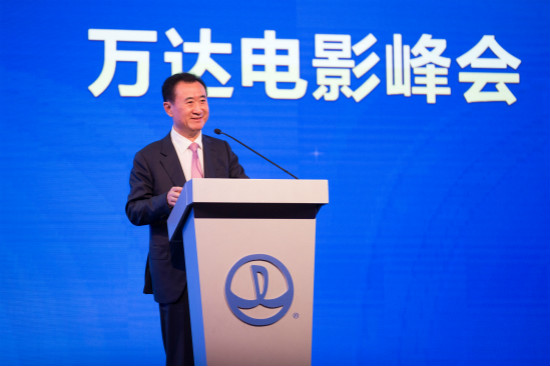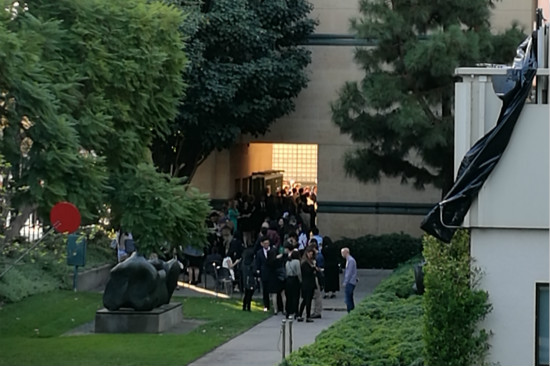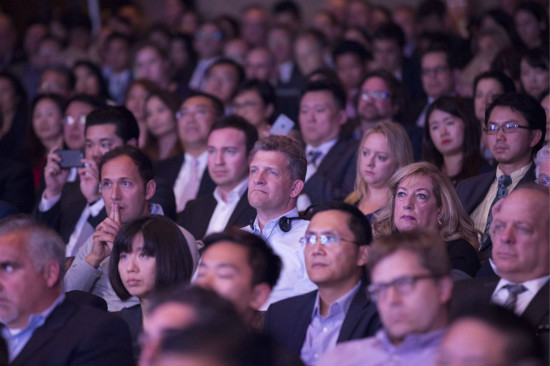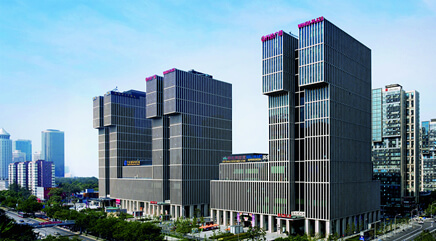Chairman Wang Jianlin makes speech at Wanda Film Summit
18.10.2016 Chairman Wang Jianlin gives a speech at Wanda Film Summit
Chairman Wang Jianlin gives a speech at Wanda Film Summit
 Attendants wait to enter the venue of the summit
Attendants wait to enter the venue of the summit
 Audience listen to the speechWanda Group Chairman Wang Jianlin attended Wanda Film Summit in Los Angeles on October 17. Chairman Wang made a speech with the theme of “The Global Film Industry’s China Opportunity”. The following is the transcript of his speech.
Audience listen to the speechWanda Group Chairman Wang Jianlin attended Wanda Film Summit in Los Angeles on October 17. Chairman Wang made a speech with the theme of “The Global Film Industry’s China Opportunity”. The following is the transcript of his speech.
Dear Mayor of Los Angeles, President of AMPAS, Vice Mayor of Qingdao, distinguished guests, ladies and gentlemen,thank you for attending this event. Welcome! I’d like to take this opportunity to share my views on China’s film industry, especially China’s opportunities for global film industry.
1. The future of China’s film market
First let me share my forecast of China’s film market. By 2016, I think China’s box office will reach RMB46 billion to RMB48 billion, or about USD7 billion to USD8 billion, up 5% to 10% from 2015. This year’s growth has been relatively slower than previous years, but I maintain my view from a few years ago: By 2018 - in two years - China’s box office will reach that of North America, surpassing USD10 billion, and the market will maintain a strong growth rate after that to become the biggest in the world.
I predict that for the next 10 years, China’s box office will see a 15% growth rate per year. Based on this projection, by 2026 China’s box office will reach USD30 billion, accounting for 40% to 50% of the global market share.
2. Why China’s box office will maintain its rapid growth
(1) Large growth potential in theater screen volume
There are 40,000 movie screens in the U.S. for a population of 300 million, or 130 screens per 1 million people. In 2016, I think the growth of China’s theater screens will slow down a bit, up by only about 8,000 to a total of 40,000, reaching U.S. numbers, and the growth will possibly continue to slow in the next few years. However, even with a slower growth rate and with China’s movie screens saturation rate reaching 80% of the U.S.’s, in 10 years China will have 140,000 to 150,000 screens, or about 3.5 times of current U.S. screens. Furthermore, an added bonus is that most of China’s theaters are newly built in the past 10 years. It’s hard to find an independently built cinema in China; almost all of them are located in shopping complexes, and revenue per screen from these cinemas is higher and more profitable and stable.
(2) Potential in average cinema attendance rate
An average American goes to the theater four times a year, while in China the average is less than one time per year in 2015. However, in 10 years, if China’s cinema attendance rate reaches that of the U.S. or slightly less, China’s box office will still be 3 times as big as the current level in North America.
(3) China’s box office shifts to sustainable growth
As you may be aware, from 2005 to 2015, China’s box office had maintained a tremendous growth rate of 30% per year. In 2015, it grew by 50%. The rapid speed is due to two reasons: Number one, the large influx of investments. The rapid rate brought forth big profit and drew more capital into the market, leading to a significant increase in movie screens and investment. The second reason is the role of the Internet in the market. In order to incentivize moviegoers, online ticket sellers in China offer 30% to 50% rebate every time a ticket is purchased. These two reasons have resulted in ultra-fast growth for China’s box office. I am of the opinion that this kind of extreme growth rate is unsustainable and shows characteristics of a bubble.
This ultra-high growth rate has made it easy to make money in the film industry, whether you are investing in cinemas, or in distribution, or in production. This trend leads to lower quality film content. Furthermore, online ticket vendors this year ceased their rebate program, which was valued at 5 billion RMB. The disappearance of this 5 billion RMB, or about 800 million USD, subsidy, has led to a box-office reduction of about 15 billion RMB, as 1 RMB subsidy leads to a 2 RMB expenditure. That’s why 2016 has been a year of slowing growth for China’s box office. Nevertheless, let me emphasize, it’s not a decline, but merely a decrease in the rate of growth. China’s box office is turning from super-fast growth to fast growth: from a global perspective, 10% to 15% is still a pretty high rate. Thus, this is a healthy self-adjustment to reduce the bubble, and the growth is becoming more sustainable. This growth rate is also driving away speculators. From 2017, I believe China’s box office will grow at a sustainable rate of 15% per year, give or take, for about 10 years. Thus I believe any pessimism about China’s film market is inaccurate. As China continues its urbanization, as the number of shopping malls grows, and as the income of the Chinese population rises, China’s film market will maintain a fast growth rate over the next 10 years.
3. How Hollywood will be able to engage and benefit from the Chinese market’s high-speed growth
First of all, Hollywood needs to strengthen collaboration with Chinese companies. You have to understand the Chinese market in order to earn profit from that market. A lot of American film companies think they understand China; however in reality, in my many years of experience talking to Hollywood, there’s a significant lack of film professionals who really understand China. It’s not easy to find folks who understand both China and the US. The best way to solve this problem is for US companies to increase their collaboration with Chinese companies, whether through financial deals, production deals, or collaboration on film techniques. Collaborating with Chinese companies and filmmakers is a very effective way of gaining a piece of the Chinese market share.
Secondly, there needs to be more Chinese elements in films. I want to emphasize that I am speaking from a purely business perspective, and have no political motivation. Because I’m a businessman, my goal is to be successful in business, so I only speak of attaining profit. Since the Chinese market will continue its robust growth, it is destined to become the largest film market, and if you want to profit from this market, you will have to understand the Chinese audience. You have to please them, and win their hearts. The best way to achieve this is to add more Chinese elements into US films and blockbusters to make the stories more relevant to a Chinese audience. And exactly how to achieve this is for Hollywood to find out. The story has to be more relevant to a Chinese audience. You cannot just expect to make money from the market while at the same time disregarding the Chinese audience and their taste, and meanwhile maintaining, like some politicians in the US have demanded, the “independence” of the films. Such a view is against the common sense of business. That is why my point is that “business is business.” We better not make it political.
Third, improve the quality of Hollywood films.
The Chinese film industry is like a student, and Hollywood is our teacher. How can a student instruct a teacher on how to improve? Hollywood is famous for its storytelling techniques. In the past, I’ve watched many great Hollywood films, with very compelling stories with unpredictable, exciting en






